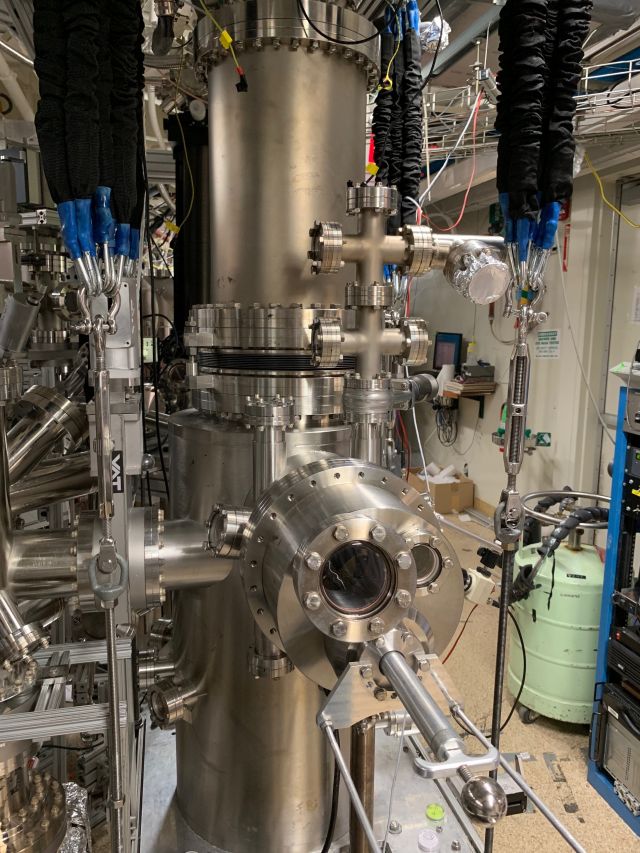In-Situ Materials Characterization
Our unique interconnected platform allows us to extensively characterize our materials systems without removing them from vacuum pre-growth, post-growth, and between growth steps. Additionally, vacuum is key to these studies because surface structure and chemistry can be drastically negatively affected by exposure to atmosphere. Our numerous load-locks give us the ability to easily analyze samples from external collaborators as well.

"The LT"
Omicron LT-STM
- Scanning an atomically sharp tip over a variably biased sample surface results in a tunnel current to the tip which allows imaging of the surface at atomic resolution
- Keeping the tip at a set location and sweeping the bias allows for I-V and dI/dV curves which serve as a direct measurement of local density of states and other properties
- Measurements can be performed at liquid He (~4 K) temperature, liquid N (~77 K), and room temperature
- Measurements are performed with the Nanonis v5 SPM control electronics
- Equipped with Omicron's qPlus sensor for AFM
- Current work on the LT-STM focuses on the study of surface reconstructions and band offsets, funded by Microsoft
"The VT"
Omicron VT-STM
- Equipped with a needle sensor for Atomic Force Microscopy (AFM) mode
- Customizations include the ability to perform Ballistic Electron Emission Microscopy/Spectroscopy
- Measurements at temperatures between 25 K and 1500 K
- Currently used to assess the quality of growths and, with BEEM, band offsets
"The ARPES"
Scienta-Omicron ARPES Lab (featuring DA30L detector and VUV5k light source)
-
Angle-Resolved Photoelectron Spectroscopy measures the kinetic energy of ejected photoelectrons excited by a UV light source
- Kinetic energy intensities as a function angle allow mapping of the band structure and Fermi surface of a sample
- Our in-situ ARPES is currently used as a probe of topological properties of materials and quality of half-metals before bringing them to beamline-level ARPES
- Equipped with Ar sputter gun for sputter-anneal cleaning procedures
"RHEED camera (electron gun not shown)"
Reflection High Energy Electron Diffraction (RHEED)
- A high energy beam of electrons (5-30 keV) is accelerated toward a sample at a glancing angle. The electrons diffract from the 2D surface and the diffracted beam maps a slice of the reciprocal space onto a phosphor screen
- Each growth chamber is equipped with RHEED such that the surface reconstruction can be measured pre- and post-growth and samples can be studied in operando as a real-time assessment of growth
- We use the FRHEED software written by former group member Elliot Young
"The XPS"
X-Ray Photoelectron Spectroscopy (XPS)
- X-rays are generated by high energy electron incident on an aluminum plate (Al K-α)
- Photoelectrons emitted via X-ray excitation probe the core levels of elements for chemical characterization of samples
- Currently used for growth feedback to optimize material quality and to measure valence band offsets
"Auger/LEED combined"
Low Energy Electron Diffraction (LEED)/Auger Electron Spectroscopy Combined Unit
- LEED uses low energy electrons and is performed at near-normal incidence as opposed to RHEED
- LEED measures the full reciprocal space of the surface, rather than a slice of the reciprocal space
- The low energy electrons incident on the sample can induce the Auger effect. The emitted Auger electrons serve to assess the chemical character of a sample in an elementally selective manner in a more surface sensitive analogue to XPS
MOKE Setup
Magneto-Optic Kerr Effect (MOKE)
- When linearly polarized light is reflected off of a magnetic sample, the polarization rotates. This is a direct measure of the magnetization of the sample via the four component dielectric tensor.
- Our set up allows for longitudinal, polar, and transverse MOKE. Sweeping the applied field in these three orthogonal directions
allows full characterization of the easy and hard axis hysteretic behavior of magnetic thin films - Rotational MOKE for measurement of anisotropy-related magnetic torques
"The Cryo-SFM"
OmicronCryo-SFM
- Mounted on a liquid Helium flow cryostat and allows low temperature STM/AFM/transport measurements with its unique optical interferometric AFM, non-magnetic construction and 12 sample contacts
- A 5-1-1 superconducting vector magnet allows for measurements under 4π solid angle magnetic field